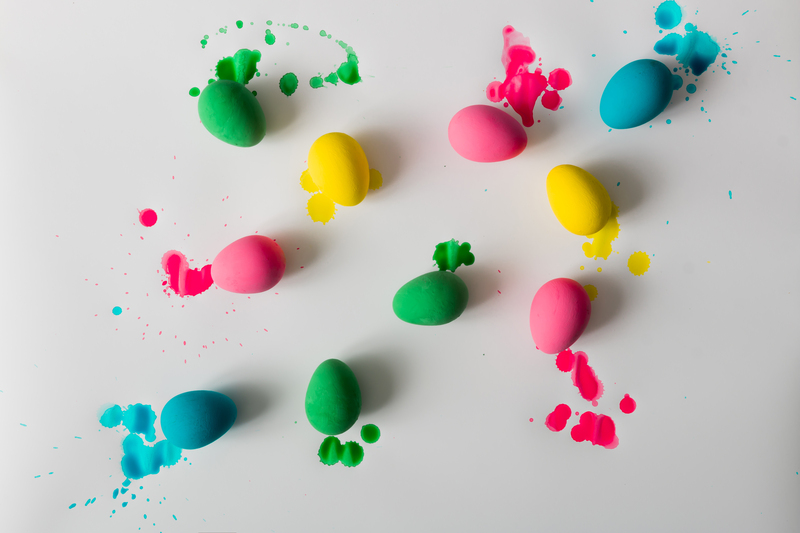Top Tips to Prevent Mold in Your Bathroom
Posted on 01/07/2025
Top Tips to Prevent Mold in Your Bathroom
If you've ever noticed unsightly black spots or a musty smell in your bathroom, you're not alone. Mold is a common issue that plagues many bathrooms due to high humidity, limited ventilation, and frequent water exposure. Mold not only ruins the aesthetics but can also trigger allergies and negatively impact indoor air quality. The good news? With the right approach, you can effectively prevent bathroom mold from taking hold.
In this in-depth guide, we'll discuss top tips to prevent mold in your bathroom, highlight common problem areas, and share actionable steps to keep your space clean and healthy. Whether you're a homeowner, renter, or property manager, these bathroom mold prevention techniques will help you maintain a fresh, safe environment.
Understanding Mold Growth in Bathrooms
Mold thrives in moist, warm environments, making bathrooms a prime breeding ground. Daily activities like hot showers and baths contribute to high humidity levels, and water often lingers on surfaces. Without proper management, mold spores can settle and multiply quickly--sometimes within just 24 to 48 hours.
- Common types of bathroom mold: Aspergillus, Cladosporium, Stachybotrys (black mold)
- Favorite spots: Shower grout, caulking, under sinks, window sills, ceilings, behind toilets
- Health effects: Allergic reactions, respiratory issues, headaches, skin irritation
Preventing bathroom mold requires a combination of moisture control, cleanliness, and proactive maintenance. Let's dive into the most effective strategies.

1. Ventilation: The First Line of Defense Against Mold
One of the top mold prevention tips is ensuring your bathroom is well-ventilated. Steam and humidity are mold's best friends, but proper air flow quickly disperses moisture that would otherwise linger.
How to Improve Bathroom Ventilation
- Install or upgrade an exhaust fan: Make sure your fan is powerful enough for your bathroom's size (measured in CFM). Run the fan during and for at least 20 minutes after every shower or bath.
- Open windows: Whenever possible, open a window to increase air circulation and let fresh air in.
- Leave the door ajar: After using the bathroom, prop the door open to let humid air escape.
Pro tip: Consider a fan with a humidity sensor for hands-free operation. Consistent ventilation is crucial to prevent moisture-induced mold in the bathroom.
2. Reduce Humidity with Dehumidifiers
High humidity is the prime cause of mold in bathrooms. To achieve optimal mold prevention, maintain indoor humidity levels between 30% and 50%.
How to Manage Bathroom Humidity
- Use a portable dehumidifier: Especially helpful in windowless or poorly ventilated spaces.
- Monitor humidity: Place a digital hygrometer in your bathroom for real-time readings.
- Limit hot showers: Lower water temperature and shower duration reduce steam buildup.
Controlling humidity with these strategies is a proactive way to prevent bathroom mold growth before it starts.
3. Wipe Down Surfaces Regularly
Leftover water is a haven for mold spores. Quick, daily maintenance goes a long way in your mold prevention efforts.
Tips for Keeping Surfaces Dry
- Squeegee shower walls and doors: Remove water after bathing to minimize residual moisture.
- Dry corners and edges: Pay special attention to less-visible areas like grout lines, caulking, and the space behind your toilet.
- Wipe counters and mirrors: Use a microfiber cloth to quickly catch condensation.
Persistent dampness fuels mold, so develop a habit of wiping down surfaces every day.
4. Clean Your Bathroom Frequently
Regular cleaning is an essential step in bathroom mold prevention. Even invisible spores can start colonies if neglected over time.
Effective Cleaning Tips for a Mold-Free Bathroom
- Use mold-fighting cleaners: Choose products with bleach, hydrogen peroxide, or vinegar for regular cleaning.
- Scrub tile grout and caulking: Dirt and soap scum trap moisture, creating an ideal mold habitat.
- Disinfect problem areas: Pay extra attention to ceilings, fans, and windowsills.
- Launder shower curtains and rugs: Wash and dry every week to prevent mold from clinging to fabrics.
For eco-friendly cleaning, white vinegar and baking soda are natural, effective alternatives that help deter mold without harsh chemicals.
5. Fix Leaks Promptly
Drips and hidden leaks are a major cause of stubborn bathroom mold. Addressing plumbing issues quickly prevents water accumulation behind walls or under floors, which is often harder to spot and treat.
How to Spot and Address Bathroom Leaks
- Check under sinks and around toilets: Look for pooling water, swollen wood, or musty smells.
- Inspect plumbing fixtures: Tighten faucets, replace worn-out washers, and check for drips in pipes or joints.
- Seal cracks and gaps: Use water-resistant caulking around tubs, sinks, and windows.
If you notice persistent moisture or unexplained dampness, don't wait--call a professional plumber to eliminate sources of leaks and protect your bathroom from mold.
6. Choose the Right Materials
Using appropriate materials in your bathroom can make a significant difference in mold prevention.
Mold-Resistant Materials and Finishes
- Mold-resistant drywall: Especially important for bathroom walls and ceilings.
- Moisture-resistant paint: Use paints with a mildew-resistant finish to discourage mold spores.
- Semi-gloss finishes: These are easier to clean and less likely to harbor mold than matte surfaces.
- Non-porous tiles and grout sealants: Prevents water penetration and mold growth in grout lines.
When remodeling or repairing, investing in mold-resistant products offers long-term protection for your bathroom.
7. Keep Clutter to a Minimum
Shower caddies, bottles, and loofahs offer surfaces where mold can thrive--especially if they stay damp. Reducing bathroom clutter enhances air flow and makes cleaning easier.
- Use open shelving: Promotes air circulation around items.
- Store essentials outside the shower: Take removable containers out between uses so they can dry.
- Hang towels to dry: Prevents them from accumulating moisture and attracting mold spores.
Remember, less is more when it comes to preventing bathroom mold.
8. Address Hard-to-Reach Areas
Mold often grows in hidden places: behind toilets, under vanities, in exhaust fan ducts, and above ceiling tiles.
Don't Overlook the Following Areas
- Check exhaust fan covers: Remove and clean these monthly to ensure proper function.
- Clean behind and under appliances: If your bathroom has a washer or dryer, check behind and underneath for moisture.
- Inspect ceiling corners: These spots often collect condensation and mold, especially in poorly ventilated conditions.
Regular inspections and deep cleans help address hidden mold before it becomes a major problem.
9. Use Mold Prevention Products
Specialty products are available to discourage mold formation. They are especially useful in bathrooms prone to high humidity.
Recommended Mold-Preventing Items
- Mold-resistant shower curtains and liners
- Grout sealants and caulking with anti-mold additives
- Moisture absorbers: Silica gel packs or automatic absorbers for persistent dampness
- Spray-on mold inhibitors: Applied after cleaning to offer a protective barrier
Using these products can supplement your regular cleaning routine to keep mold at bay.
10. Schedule Regular Inspections
Catch potential problems before they escalate by scheduling regular bathroom inspections for mold, especially if you own or manage rental properties.
- Look for discoloration, peeling, or musty odors
- Test for leaks or trapped moisture
- Evaluate the effectiveness of your ventilation system
Early detection is the best way to avoid expensive repairs and protect your bathroom from persistent mold issues.

Frequently Asked Questions About Bathroom Mold Prevention
1. What temperature should I keep my bathroom to prevent mold?
Mold prefers warmth. Keeping your bathroom slightly cooler--especially after a hot shower--and ensuring quick moisture removal will reduce the likelihood of mold growth. Use humidity and temperature monitors to maintain an optimal environment.
2. Can plants help control bathroom mold?
Certain houseplants, like ferns or peace lilies, can help absorb some moisture but are not a stand-alone solution. In fact, overwatering or letting soil remain damp can actually contribute to mold. Always practice comprehensive moisture control measures.
3. Is bleach the best cleaner for bathroom mold?
Bleach is effective in killing surface mold but may not penetrate porous materials like grout. Alternatives such as hydrogen peroxide and white vinegar are also effective and safe for regular use. Persistent mold may require professional remediation.
Conclusion: Mastering Bathroom Mold Prevention
Preventing mold in your bathroom doesn't have to be overwhelming or expensive. By focusing on ventilation, moisture control, regular cleaning, and smart material choices, you can keep your bathroom fresh, healthy, and mold-free all year round.
- Ventilate and reduce humidity every day
- Fix leaks and wipe surfaces often
- Clean with mold-fighting products and inspect hard-to-see areas
- Use mold-resistant materials and keep clutter to a minimum
For more bathroom mold prevention tips and home maintenance guides, bookmark our site and check out our latest articles. A healthy bathroom is key to a healthy home--take action against mold before it starts!



